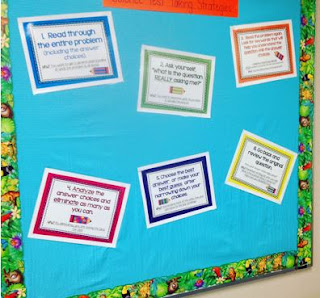
Testing overload. No doubt about it. Between district testing for some, in addition to state testing, it feels difficult to justify giving our poor students a chapter test too… and it just doesn’t seem to be getting any better. Perhaps some aren’t feeling the stress, but most teachers and students I know are just flat burnt out on testing. Teaching 5th grade for 6 years has given me a heavy dose of this reality.
As if the number of tests aren't enough, math and science
questions are usually embedded in a sea of reading. If a child struggles to read and
understand what the question is asking, how can they solve the math problem
buried in it? It is so important to help students learn to problem solve and
think critically, with or without high-stakes testing. I start helping my students prepare from about the third
week of school. You may be thinking that is overkill and too early… but not
when done properly. If anything, it has helped my students to become confident
test takers with far less stress. We work on specific routines that don’t
actually feel much like test prep, and we practice all year long. I feel that
it is about helping students to form good habits long term, not slamming
strategies in shortly before, which can add to the stress of the test.
I would
like to share with you how I help my students prepare all year, with low
anxiety and great success. The guided toolkit I will refer to is a collection
of strategies and procedures that I have put together to increase my students’
success in problem solving multiple choice word problems. They may seem like
common sense, and they probably are! However, I believe that many teachers are
looking for help in implementing test-taking strategies at a variety of grade
levels.
***So how do I do it? Through a
Question of the Day routine with specific critical-thinking, problem solving
strategies. Oh, and you will see that this becomes STUDENT-LED, so the focus is
on keeping students on track while letting them do the thinking!***
Imagine this: one of your
students is standing at the front of the room with the projector displaying the
Question of the Day. The students have already worked the problem out on their
own paper. Today’s student leader is calling on students and leading the class
through each strategy while discussing the “how” and “why” for each
decision they make. You have a backseat role as you observe how awesome your
students really are as they work together to problem-solve. Occasionally you
throw in the assist and do what a teacher does best, but overall, they are running
the show. I LOVE watching my students get better at this all throughout the
year and they LOVE when it is their turn to be the “teacher.”
* First, I introduce students
to the critical thinking, problem-solving strategies that students can rely on
and use all year long. Click here to get my test-taking strategies posters FREE!!! I have created a
gradual release PowerPoint presentation to guide both teacher and students
through this process (YOU learn along with your kiddos!)
* Students receive a
strategies guide card (laminate them to use over and over with an Expo marker!)
they use to mark off each strategy as they work through their Question of the
Day problem. Eventually they won’t need this anymore, but they like to be able
to follow step-by-step at the beginning.
* Use the first two weeks of
questions in my toolkit (or any questions you find beneficial) and work through
one each day using the student guide card. You lead for the first day or two,
and then gradually let students begin to take over. The two-week set (10 days)
of questions are focused on “Making Inferences in Science.” The questions are
based on my Making Inferences in Science Task Cards.
Of course, this is just a
very brief overview of how it works, so check out the PREVIEW HERE to see more!
Please note, these strategies
are intended for multiple-choice questions, but as I will mention later, can
also be adapted to fit other types of questions as well. This resource is intended
to be a GUIDE, not a perfect to-do list. It is NOT research-based. It is simply
a resource I created to share what has worked for me in MY classroom with MUCH
practice throughout the year.
(I
make no claims that you will see increased test scores by using this resource,
but if you read feedback
from teachers that have purchased my toolkit, you’ll see they love it!)
The most important piece of
advice is to start as soon as you can and PRACTICE every day if possible, or at
least most days. This lends itself perfectly to morning work time. The idea is
to develop habits so that come test time, students are ready to tackle the
challenge and hopefully won’t feel nearly as anxious. It takes a bit of the edge off for you too. J










No comments:
Post a Comment